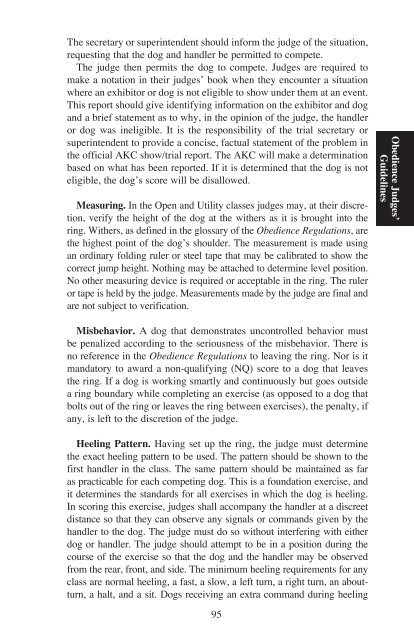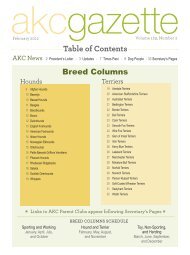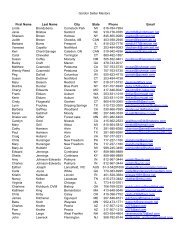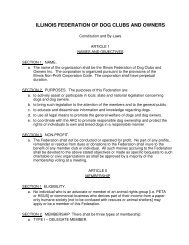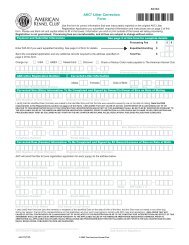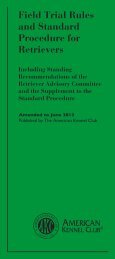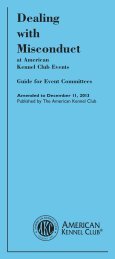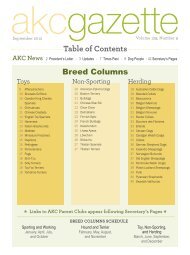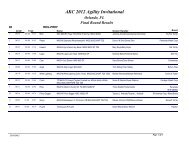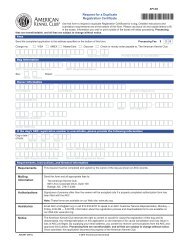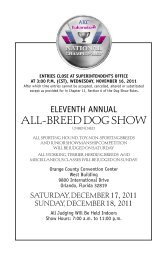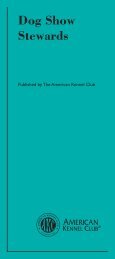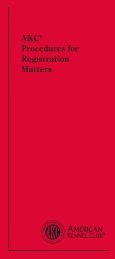Obedience Regulations - American Kennel Club
Obedience Regulations - American Kennel Club
Obedience Regulations - American Kennel Club
Create successful ePaper yourself
Turn your PDF publications into a flip-book with our unique Google optimized e-Paper software.
the secretary or superintendent should inform the judge of the situation,<br />
requesting that the dog and handler be permitted to compete.<br />
the judge then permits the dog to compete. Judges are required to<br />
make a notation in their judges’ book when they encounter a situation<br />
where an exhibitor or dog is not eligible to show under them at an event.<br />
this report should give identifying information on the exhibitor and dog<br />
and a brief statement as to why, in the opinion of the judge, the handler<br />
or dog was ineligible. it is the responsibility of the trial secretary or<br />
superintendent to provide a concise, factual statement of the problem in<br />
the official AKc show/trial report. the AKc will make a determination<br />
based on what has been reported. if it is determined that the dog is not<br />
eligible, the dog’s score will be disallowed.<br />
Measuring. in the open and utility classes judges may, at their discretion,<br />
verify the height of the dog at the withers as it is brought into the<br />
ring. Withers, as defined in the glossary of the <strong>Obedience</strong> <strong>Regulations</strong>, are<br />
the highest point of the dog’s shoulder. the measurement is made using<br />
an ordinary folding ruler or steel tape that may be calibrated to show the<br />
correct jump height. nothing may be attached to determine level position.<br />
no other measuring device is required or acceptable in the ring. the ruler<br />
or tape is held by the judge. measurements made by the judge are final and<br />
are not subject to verification.<br />
Misbehavior. A dog that demonstrates uncontrolled behavior must<br />
be penalized according to the seriousness of the misbehavior. there is<br />
no reference in the <strong>Obedience</strong> <strong>Regulations</strong> to leaving the ring. nor is it<br />
mandatory to award a non-qualifying (nQ) score to a dog that leaves<br />
the ring. if a dog is working smartly and continuously but goes outside<br />
a ring boundary while completing an exercise (as opposed to a dog that<br />
bolts out of the ring or leaves the ring between exercises), the penalty, if<br />
any, is left to the discretion of the judge.<br />
Heeling Pattern. Having set up the ring, the judge must determine<br />
the exact heeling pattern to be used. the pattern should be shown to the<br />
first handler in the class. the same pattern should be maintained as far<br />
as practicable for each competing dog. this is a foundation exercise, and<br />
it determines the standards for all exercises in which the dog is heeling.<br />
in scoring this exercise, judges shall accompany the handler at a discreet<br />
distance so that they can observe any signals or commands given by the<br />
handler to the dog. the judge must do so without interfering with either<br />
dog or handler. the judge should attempt to be in a position during the<br />
course of the exercise so that the dog and the handler may be observed<br />
from the rear, front, and side. the minimum heeling requirements for any<br />
class are normal heeling, a fast, a slow, a left turn, a right turn, an aboutturn,<br />
a halt, and a sit. Dogs receiving an extra command during heeling<br />
95<br />
<strong>Obedience</strong> Judges’<br />
Guidelines


